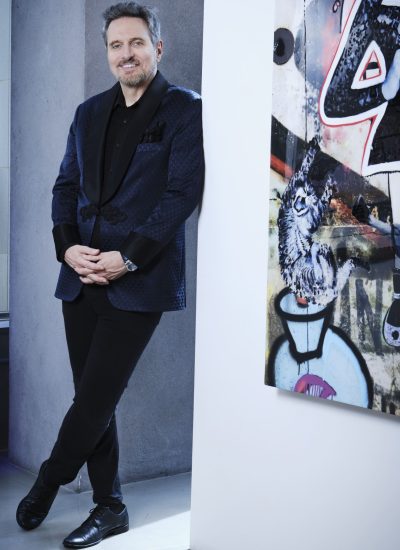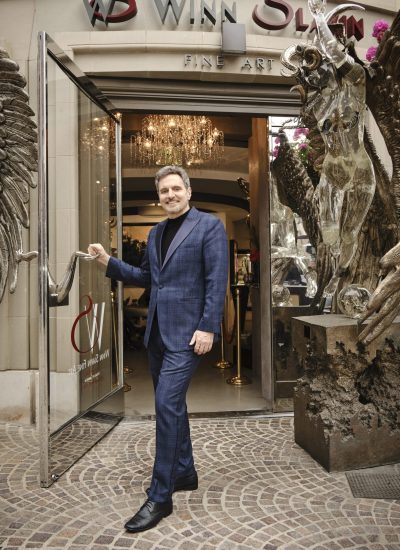Interview By Teresa Greco
The allure of fine art as an investment has captivated collectors and investors for centuries. Its potential for both aesthetic pleasure and financial gain has made it a sought-after asset class. However, navigating the complexities of the art market requires a nuanced understanding of its unique characteristics and potential pitfalls.
Many believe that simply holding onto artwork will inevitably lead to value appreciation, but this holds true for only a select few artists. Likewise, the illiquidity of art and the complexities of selling it—especially through auction houses with their steep fees—are often overlooked.
Randall J. Slavin, an esteemed fine art dealer and founder of Winn Slavin Fine Art, offers his seasoned expertise on these topics, providing key strategies for navigating the intricate world of art investment.


Given the increasing interest in fine art as an investment, what are the most common misconceptions or misunderstandings that you encounter among potential clients?
Perhaps the most common misconception is that if an artwork is held long enough, it will increase in value. That isn’t true for the vast majority of artwork. The artwork that will increase in value is artwork by recognizable, well-managed artists—a small minority of the millions of artists worldwide.
Liquidity is another misunderstood concept. Artwork is a non-essential luxury good that is typically high-priced. That means the number of potential buyers is relatively small. Those buyers are also challenging to reach and often suspicious of individuals selling artworks independently because of the potential for fraud and forgeries.
There is also a lack of understanding of art auction houses. Generally, they aren’t a profitable way to buy and sell artwork because of premiums. The major auction houses add on 20% to 28% buyer premiums and take a seller’s premium from the final auction price. It’s also tough to place artwork at the major auction houses as roughly 93% of auction spending is on the top 100 artists. So even if you can absorb the premiums—if you don’t have one of those artists—it’s unlikely that the auction houses will even accept the consignment.
How do you assess the authenticity and provenance of artworks, particularly in a market that has seen an increase in forgeries?
Forgeries and unauthenticated artworks are a problem in the art market. It’s primarily an issue with well-known deceased artists and less common among living Contemporary artists. If an artist is still living, they can easily authenticate their own work. Also, with the rise of digital photography over the past few decades, there are much better records of authentic artwork. For a deceased artist, the authenticators are often family members, business associates, or scholars who have spent much time studying the artist’s oeuvre. Even so, the authenticity of a work can be elusive.
That’s where provenance comes into play. Provenance is the history and paper trail of how a work got from the artist’s easel to its current owner. It also includes documentation, such as exhibition catalogs, that help to confirm the artist’s authorship of the artwork. An artwork with well-documented and unbroken provenance is far more likely to be authenticated.
What strategies can be employed to mitigate the illiquidity risk associated with fine art investments?
It’s essential to understand why you’re buying, what you’re buying, and who you’re buying from. I typically advise against buying art to flip it since there aren’t any guarantees that an artwork will go up in value or even retain its current value. First, you should buy an artwork because you love it, because it speaks to you, and because you value the message the artist is communicating. If you buy for that reason, you’ll always have something that has value to you, even if its monetary value doesn’t increase.
Understanding what you’re buying is also important. Because of their rarity and uniqueness, original paintings are more likely to increase in value than limited edition prints. Sculptures, even limited-edition sculptures, are also more likely to retain and increase in value. If you are buying a limited-edition work, the edition size is an important factor in determining long-term value appreciation.
Also, consider who you’re buying from. If you’re buying from a private seller, they may not have the expertise to understand the work’s authenticity and generally won’t have a reputation they need to protect. Buying directly from an artist is also a mixed bag because most self-represented artists don’t have gallery representation, which is a critical factor in protecting and increasing the value of an artist’s work. Your safest bet is to buy from a reputable gallery that has the expertise to know what they’re selling, a reputation to protect, and an interest in promoting the artist’s work over the long term.
In your experience, how has the role of wealth managers evolved in the art market, and what services do they typically offer to their clients?
Wealth managers are increasingly offering services around art buying. Most recognize the potential upside of art investing and are able to connect their clients with reliable resources for acquiring, authenticating, appraising, and leveraging their collections. Increasingly, wealth managers are involved with art-secured lending, often through their own institutions.
Considering the auction house fees and premiums, what factors should collectors consider when deciding whether to purchase art through an auction or directly from a gallery?
I recommend buying through an auction house only as a last resort. First, when you go to an auction, the bidding is often more about winning than the artwork. That can result in inflated prices because many auction bidders are uninformed and usually bidding emotionally. Second, auction houses do not guarantee the authenticity of the work that you buy from them. They do their best to verify the art, but there are numerous horror stories about that process going wrong. Factor in the fees and premiums, and it’s easy to see why it’s not the best venue. However, high-demand work, particularly by deceased artists, is often unavailable at any other venue.
How can art-secured lending be used as a strategic tool to enhance liquidity and access capital without selling the artwork?
Loans secured by art are increasingly popular—so much so that even the auction houses are getting in on the action. Sources place the total loans secured by artwork at around $25 billion in 2021, increasing substantially yearly. They’re especially popular in the U.S. because the States account for about 40% of the global art market, and the Uniform Commercial Code allows the owner to retain possession of the artwork used as security for a loan. As a rule of thumb, lenders will lend 50% of the appraised value of the securing artwork. Note: that’s the current appraised value, not the original purchase price.
Given the potential for tax benefits, what factors should collectors consider when evaluating the suitability of donating artwork to a qualified charity?
Donating artwork that has increased in value can net significant gains through tax deductions. It’s all about the math. Assuming you’ve held the artwork for at least one year, are donating to a qualified charity, and have an independent appraisal, you can deduct the artwork’s fair market value (i.e., its current appraised value.). So, if you donate an artwork that’s currently valued at $100,000 and you’re in a 50% combined state and federal income tax bracket, you’re saving $50,000 in taxes by making that donation. If you made a smart investment when buying the artwork and the artist’s career has been well managed, you can actually realize a profit by doing so. For example, if you paid $20,000 for the artwork, you’re realizing a profit of $30,000 by donating it. While you could potentially realize more profit by selling the artwork, finding a buyer can be extremely difficult and take years, if at all. Donation, on the other hand, is entirely at your discretion and at your own time.
How do you assess the long-term investment potential of an artist and their work, particularly for emerging or mid-career artists?
I advise collectors to look at a variety of factors. First, is the artist’s work unique and meaningful? If they’re doing the same thing that others are doing, or even doing something that others can do, it will be much harder for that artist to achieve the recognition necessary to increase the value of the artwork. Also, if they’re just painting pretty pictures that have no message, no deeper meaning, collectors will lose interest.
Second, who’s behind the artist? Self-represented artists are notorious for doing foolish things and sabotaging their own careers. An artist who is professionally represented by a reputable gallery or agency is far less likely to make those mistakes.
Third, has the artist exhibited significant evolution of their technique and style over their career? It’s not uncommon for an artist, even a well-represented one, to get so stuck on a particular subject matter or style of work that the work becomes trite, stale, and routine. That can end an artist’s career as surely as doing foolish things.
Randall J. Slavin is an American entrepreneur, fine art dealer, and philanthropist. As the proprietor of Winn Slavin Fine Art, with galleries in Beverly Hills, Shanghai, and Vietnam, he has been a premier provider of international fine art since 1997. Slavin founded Masterpiece Publishing to connect collectors with quality artwork while protecting artists’ reputations. He is the publisher of Art Confidential, a luxury lifestyle magazine, and CEO of WS Productions, for which he executive produced the cinematic short Creation and its prequel Ectropy: From Chaos to Order. For more information on Randall, please visit: winnslavin.com.

